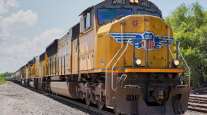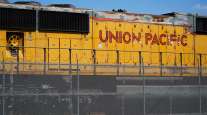Senior Reporter
Union Pacific Reports Strong Q1 Earnings

[Stay on top of transportation news: Get TTNews in your inbox.]
Union Pacific Corp. reported first-quarter earnings that outpaced Wall Street expectations, even as its quarterly revenue dipped.
The company on April 23 reported that Q1 net income rose 5.7% to $1.47 billion, or $2.15 a share, compared with $1.39 billion, or $1.94, in the same period a year ago. The Zacks Consensus Estimate was for $1.86 per share. However, Union Pacific said quarterly revenue declined 2.9%, to $5.23 billion from $5.38 billion in the year-ago period.
The Class I railroad’s operating ratio improved to 59 from 63.6. Operating ratio, or operating expenses as a percentage of revenue, is used to measure efficiency. The lower the ratio, the higher the company’s ability to generate profit.
Union Pacific ( $UNP ) Reports Strong First Quarter 2020 Results https://t.co/F6GQWS3lLf — Union Pacific (@UnionPacific) April 23, 2020
“Against the backdrop of the emerging COVID-19 pandemic and a challenging volume environment, we leveraged productivity to deliver strong financial results, including an all-time best operating ratio of 59%,” Union Pacific CEO Lance Fritz said. “We also made substantial improvement in employee safety, which is a testament to our dedicated employees. Our rail network has never run better, providing a safer, more reliable, and efficient service product to our customers.”
The company noted that the falling price of diesel fuel helped its bottom-line results — its fuel costs are 10% below what they were a year ago.
Its adoption of precision-scheduled railroading — which is designed to lower costs and improve overall efficiency by increasing the number of freight cars that are moving in the system on fewer trains — is also paying off.
“Union Pacific is running at efficiency levels we’ve never experienced before as a company,” chief financial officer Jennifer Hamann said on a conference call with reporters and analysts. “With the strength of our balance sheet and our strong cash generation, I can confidently say that we are well-positioned for the challenges we are facing.”
Hamann also disclosed that the railroad is operating with 15% fewer employees — about 6,200 people — compared with Q1 2019. Fritz revealed earlier this year to the Wall Street Journal that the company was curtailing about 3,000 staff in 2020, but at that time didn’t rule out further cuts.

Much of the trucking industry relies on older onboard technology for critical functions, which can hurt reliability and efficiency. So is it time for fleets and their technology vendors to implement faster replacement cycles for onboard tech? Seth Clevenger talks to Ray Greer of Omnitracs and Deryk Powell of Velociti. Hear a snippet, above, and get the full program by going to RoadSigns.TTNews.com.
As a result of the coronavirus, company officials said they are anticipating the rest of the year could be difficult.
“Our second-quarter car loadings are currently down 22%, and our current view is that volumes for the full quarter could be down around 25% or so. With volume declines of that magnitude, we are taking actions across the board to rightsize our resources and manage expenses,” Hamann said. “Even with aggressive actions, however, it is unlikely we can improve our second-quarter operating ratio on a year-over-year basis with that level of volume loss.”
Broken down by sector, revenue in the bulk freight category fell 5% to $1.53 billion from $1.62 billion last year. That group includes grain and grain products, fertilizer, food, and refrigerated cargo, along with coal and renewables. Coal and renewables alone declined 19%, which brought down the entire segment.
Industrial freight, which includes chemicals and plastics, metals and minerals, forest products, and energy and specialized markets, was up 3%, to $1.89 billion from $1.83 million.
Premium cargo, which includes automotive and intermodal, fell 6%, to $1.45 billion from $1.55 billion in 2019.
Want more news? Listen to today's daily briefing:




